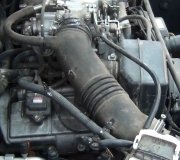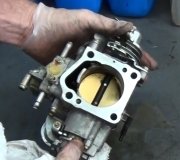The cold air intake likely did not cause this problem, but they defeat the purpose of the intake manifold. The thinking is colder air is more dense so you can pack more of into the cylinders. The Engine Computer will see the additional air and command more fuel to go with it, and that is supposed to give you more power. That's fine if you drive at wide-open-throttle all the time. Any time you have the accelerator at less than wide-open-throttle, you're blocking air flow so there's no point in trying to condense the air. The Engine Computer will add more fuel, just as it does in colder weather, to insure enough fuel vaporizes for the engine's needs. The rest will go out the tail pipe, wasted.
The biggest problem is liquid gasoline does not burn. In addition, when you pull air across the throttle blade and the pressure goes down, it gets real cold. That's the principle of how air conditioning works. The goal of the intake manifold is to warm up the air so the fuel will vaporize better and burn completely in the engine. We used to need chokes on carburetors to dump in a pile of raw gas in hopes enough percentage would vaporize to make the engine run right. All engines had some type of exhaust passage that warmed up the base of the carburetor to vaporize the fuel better. You might wan to rethink what you're trying to accomplish with the cold air system.
As for the temperature gauge, there's two common things to consider. The first is a leaking cylinder head gasket. If combustion gases leak into the cooling system, that air can pool under the thermostat. Thermostats don't open in response to hot air. They must be hit with hot liquid. However, once the engine is warmed up and the thermostat opens, any air should sail right through and eventually find its way into the reservoir. There's a chemical test your mechanic can do to test for a leaking head gasket. It takes about five minutes. You can also borrow the tool from many auto parts stores that rent or borrow them, but they will usually make you buy a bottle of the special liquid. That's because if it gets contaminated with coolant, it wont work and the next guy could get inaccurate results.
The other thing to look at is the cooling fins on the radiator. If they are corroded and crumble when you touch them, they wont give up the heat to the air. That is more common in states that throw a pound of road salt on an ounce of snow. Usually the overheating comes on gradually over the course of a year or more, and it occurs more at highway speeds where more heat is generated but the natural air flow is ineffective.
Monday, January 27th, 2014 AT 3:05 PM


